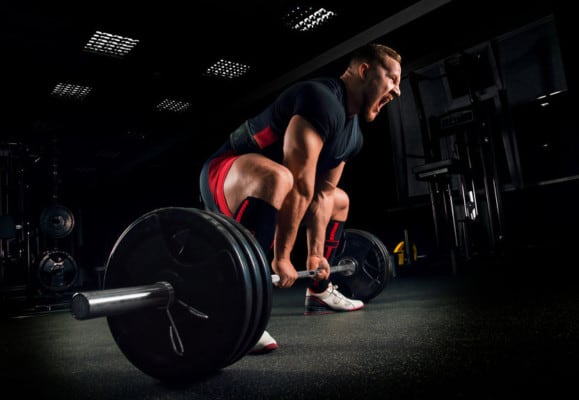We are going to look at the differences and between a Romanian deadlift verse a conventional deadlift. And which one is better. The deadlift, in general, is one of the best exercises because it creates full-body strength while training more than one muscle group at a time. We’re going to take a look at which deadlift technique is better.
Studies have shown that conventional deadlift is a far superior exercise verse the Romanian deadlift. Electromyography (EMG) tests have been used to look at the reactions of the muscles during these two types of deadlifts. The conventional deadlift is much better at training for the rectus femoris and the gluteus maximus. The conventional deadlift also scored positively higher for ankle and knee torque known as NJT.
Therefore, the purpose of this study was to determine which deadlift technique is a better training protocol between the conventional and the Romanian deadlifts as indicated by the greater demand in muscle activities and joint kinetics.
The conventional deadlift would be a better technique for training the rectus femoris and gluteus maximus than the Romanian deadlift as indicated by the greater EMG and NJT values.**
Your gluteus maximus is located in your “buttocks as Forrest Gump” would reference. While your rectus femoris is located in the middle part of your quadriceps muscle or thigh.
| The conventional deadlift is better than the Romanian deadlift when it comes to overall increasing strength and muscle. |
What is the Romanian Deadlift?
The Romanian deadlift is used to target multiple post chain muscles and stabilizers. The main muscle being worked are the Glutes and Hamstrings. With the secondary being lower back, middle and upper back, traps and forearms.
The biggest difference between the Romanian deadlift and the conventional is how they are used. When you are doing a Romanian deadlift the focus is on the eccentric movement. Which is the lower of the weight on the way down.
The deadlift is the complete opposite while the focus on the movements, it’s more of a concentric movement where you are focusing on the way up. You are also able to lift a lot more load(weight) doing conventional verse Romanian.
There are still a number of benefits from doing the Romanian deadlift. I personally prefer it over conventional most of the time even though conventional is better.
Romanian Deadlift Benefits
- Increased pulling power
- More of increase in Hamstring Hypertrophy
- Injury prevention
- Sports improvements
What is the Conventional Deadlift?
The deadlift is one of the most popular exercises for good reason, it works more than one muscle group at time. This is why compound exercises are far better than your standard isolation exercises.
The primary muscle groups that are worked during a conventional deadlift are glutes, hamstrings, lats, quads, traps, obliques, rhomboids and forearms.
The deadlift and the Romanian deadlift focus on two different movements. As mentioned earlier deadlift more of a concentric movement focusing on the way up and the Romanian is focused on the eccentric on the way down.
Benefits of Deadlifts
- Fat burning
- multiple muscles worked at once
- Injury prevention
- Improved ADL’s
- Increase in hormones such as Testosterone
Let’s look at why the Conventional Deadlift is Better
There was a study performed that looked at two deadlifting techniques. These were the Conventional verse the Romanian deadlift. Things that were being looked at were the differences in joint kinetics along, and activities within the muscle.
Electromyographic is used to look at different variables compared between Romanian verse conventional deadlift. Essentially placing EMG on the muscles being worked and relaying real-time evidence.
The other variables used were myoelectric activities of muscles like the biceps, rectus femoris, and glutes and lower extremity net joint torque also known as NJT.
This is a great way to prove which is better and far better than a “Bro” telling you it is because he read it somewhere. During the research 21 males lifted their 1RM at 70% on the deadlift. This was also determined by finding their 1RM for testing.
The age group of the males was 22 years old. They all had a decent amount of time training of 3 years with conventional and Romanian deadlift technique. So not exactly beginners or advanced lifters for that matter.
They also used the same 1 RM for both the Romanian and conventional deadlift. The participants were asked to use a slight 15% bend in the knees while performing the exercises.
Before the actual testing was conducted the participants did a warm-up of 5 minutes on a stationary bike. This was followed by them doing practice deadlift trials.
The practice trial rounds of deadlifting were practiced at 12 reps with a barbell weight of 20.4kg (44lbs). Then they lowered the rep range down to 8 and increased the weight to 61 kg (134 lbs)
They took the men for the study and randomly assigned them to either a Romanian or Conventional deadlift. From there they tested at a total 10n deadlifts trials.
This was 2 techniques x 5 trial deadlifts per technique at 70% of Romanian 1rm rotating because it’s what is used most often while doing resistance training.
As for the stance, it was your typical pelvic with 100% while using the double overhand grip style for both trials. As far a the tempo or speed used they let the participants pick so it didn’t feel awkward or mechanical like.
Once all of their details were worked out and they felt comfortable they asked that they were all consistent in terms of grip width and speed of the exercise. The rest periods were set to at least 2 minutes of rest to help stay consistent and prevent fatigue from setting in.
Here is an example of what the study looked like
| A warm-up with 5-10% repetitions at 50% of rep maximum |
| Followed by a warm-up by completing 3-5 repetitions with an increase of 15kg (33 lbs) |
| Almost a maximum of 1RM to finish while adding 15 kg (33 lbs) |
| A weight increase by adding 15 kg (33lbs), followed up with 1RM |
| If they failed the exercise they rest for 2-4 minutes, then would decrease the load by 8 kg (17 lbs). |
| However, if succeeded they would rest for 2-4 minute rest period they would repeat this step: A weight increase by adding 15 kg (33lbs), followed up with 1RM |
Final Thoughts
During the research, the EMG showed significantly higher value from the rectus femoris and the glutes from the conventional deadlift verse the Romanian deadlift. The conventional deadlift had significantly more knee and ankle torque (NJT) which is good. Does this mean to never do Romanian deadlifts, no. Although I would spend more of my time doing conventional deadlifts and mixing in Romanian every once in a while.

